





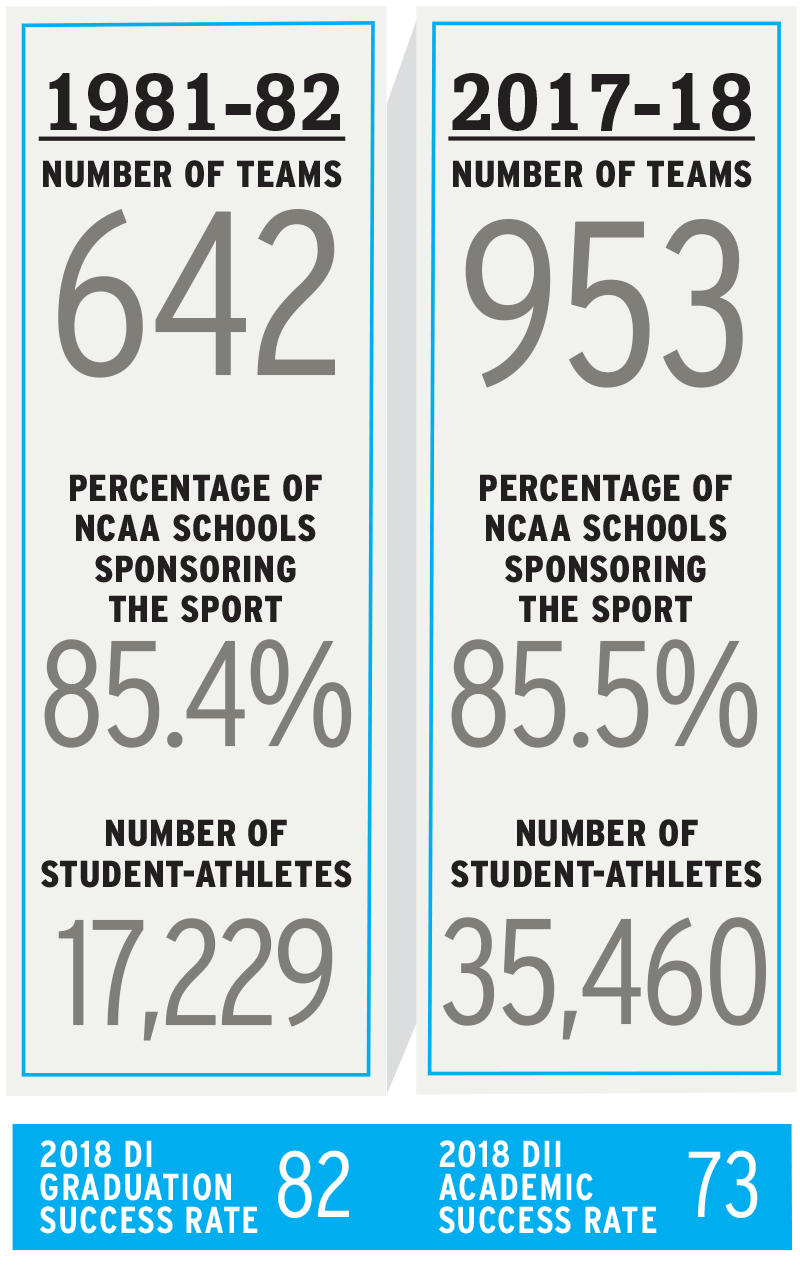
On the field, rules governing pace of play and umpiring accuracy have become priorities. For the upcoming 2019 season, coaches can make two video review challenges per game in stadiums where the technology is available. The on-field umpires and the off-field video review official also can initiate a review when warranted.
During the 2017-18 academic year, 35,460 players took the diamond, making baseball the second-largest NCAA sport. Only football (73,557) has more participants.
The baseball community is focused on ensuring the sport’s Academic Progress Rate continues to climb. In the 2016-17 academic year, the sport’s APR was 977, 13th among men’s sports and up from 935 a decade ago. In August 2006, a 26-member NCAA Baseball Academic Enhancement Working Group — composed of athletics directors, conference commissioners, coaches, faculty athletics representatives and the executive director of the American Baseball Coaches Association — was charged with recommending changes to improve academic performance among baseball players.
“For baseball to only have 11.7 scholarships available for an entire team is disappointing to our coaches. It’s just an area that we would like to see improved. We don’t want to sound negative, because there is progress being made in our sport on campuses with the facilities, coaching salaries and operating budgets. That hasn’t gone unnoticed by our coaches.”
Craig Keilitz | American Baseball Coaches Association executive director

Though the sport has drawn headlines over the past year for off-the-court indiscretions, incremental on-the-court enhancements are still underway. A package of changes adopted before the 2015-16 season, for instance, was designed to improve the pace of play, better balance offense with defense and reduce physicality. Scoring in Division I games was at 67.6 points before the rules changes and has remained steady (between 73 and 74 points) in each of the three subsequent seasons.
Men’s basketball is sponsored at 97.6 percent of NCAA schools, the most among any men’s sport. Almost 19,000 student-athletes competed in men’s basketball in the 2017-18 academic year.
Reform has been top of mind amid an FBI investigation and federal trials involving coaches, shoe and apparel companies, and various interlopers. Amid the fallout, the recruiting calendar has been reshaped with an emphasis on summer recruiting camps where NCAA coaches can evaluate players. There, recruits will have access to educational programming regarding eligibility and other vital issues.
“We work with our coaches to recognize that even though they individually may not be a part of the federal investigation or trials, the game and the profession are perceived as a whole with a broad brush. We all need to take on the responsibility of change. Now, we have change through the Commission on College Basketball. Part of our challenge is to remember where we were and why these changes are coming.”
Jim Haney | National Association of Basketball Coaches executive director
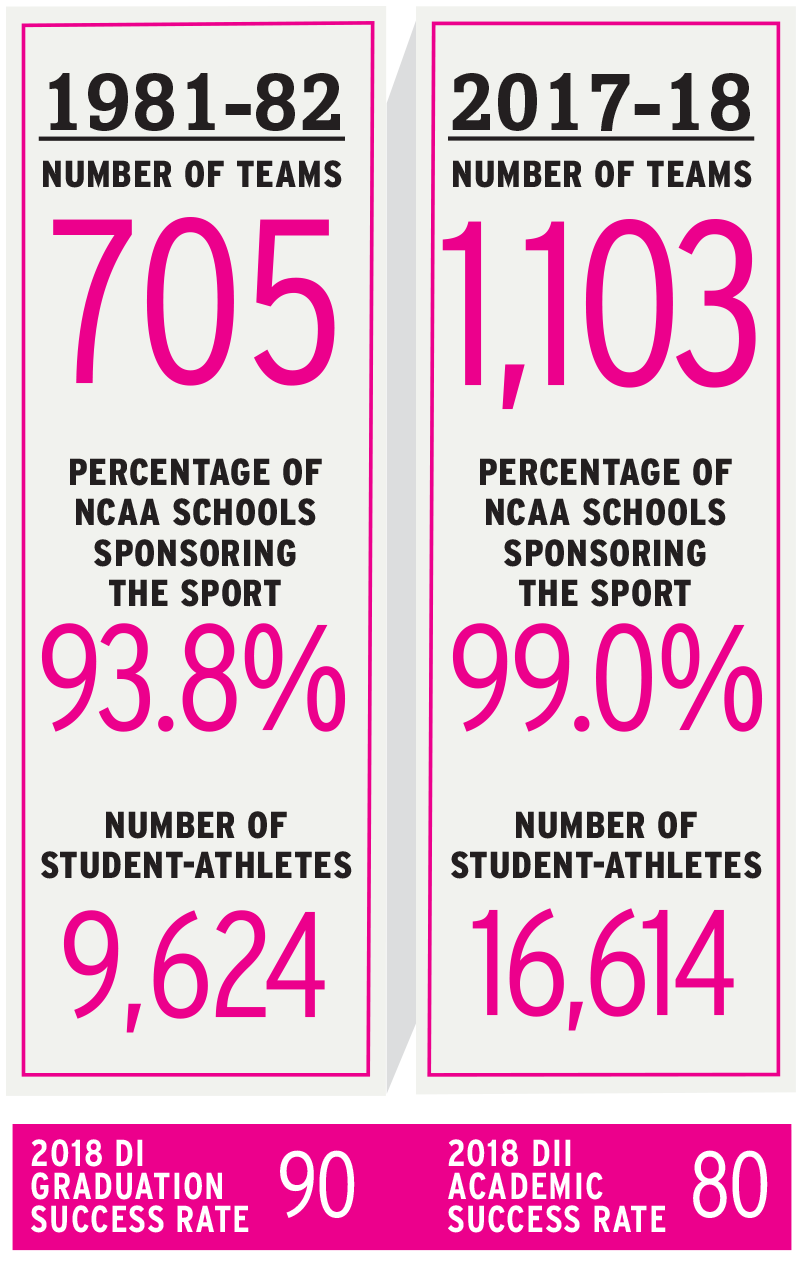
Seeking to make the sport more fluid, NCAA women’s basketball introduced a four-quarter format before the 2015-16 season. Rather than long halves devolving into free-throw shooting contests, teams now reach the bonus on the fifth team foul of each quarter. The average number of free-throw attempts has decreased in each of the past three seasons in Division I, with 17.1 foul shots attempted per game in 2017-18. While free-throw stoppages are trending down, scoring is ticking up, albeit slightly — last season, teams averaged 65.9 points per game, about a point higher than the season before the new format was introduced.
Women’s basketball is the most-sponsored sport in the Association — 99 percent of the schools have varsity teams.
The Women’s Basketball Coaches Association has spent considerable time looking ahead into the next decade. The organization has finalized a code of ethics; has developed a strategic plan to increase popularity and participation and to grow its membership; and is preparing coaches and players to become leaders in society.
“Our game is in a place of strength right now. … Our strategic plan is focused on the next three years through 2021. The three main areas are stewardship, membership and education — we will be laser focused.”
Danielle Donehew | Women’s Basketball Coaches Association executive director

Beach volleyball was added to the list of emerging sports for women in August 2010. By 2015, more than 40 schools sponsored varsity teams, clearing the threshold to become the NCAA’s 90th championship. The inaugural event was held in May 2016 in Gulf Shores, Alabama.
Sixty-eight schools fielded varsity beach volleyball teams during the 2017-18 academic year, marking a 134.5 percent increase from the 2012-13 academic year.
All three championships have been televised — Turner Sports aired the first two; ESPN covered the 2018 event — and more exposure is on the horizon. ESPN purchased the rights to broadcast the eight-team event through 2022. With the competition set against Gulf Shores’ white sand beaches, viewers will see athletes who must be able to pass, set, dig and hit on any given play, different from their indoor counterparts, whose skill sets tend to be more specialized.
“When you have live television coverage of an event like this, it is good for the sport and the Gulf Shores community. … This college beach championship is helping transform this town.”
Kathy DeBoer | American Volleyball Coaches Association executive director
The newest of the NCAA’s 90 championships, beach volleyball’s event has evolved apace, transforming the white sand beaches of Gulf Shores, Alabama, every spring. That community, which sits on the Gulf of Mexico 34 miles west of Pensacola, Florida, has hosted the first three championships, and the event is scheduled to take place there through 2022.
Each year since the first championship in 2016, the hosts at Gulf Shores have made changes, so the event is more appealing for spectators. Organizers have built a 5-foot-wide boardwalk that curves along the beach to provide better access to the venue and have placed grass over the sand to allow spectators to maneuver easily among the five courts. They’ve also included risers to help spectators sitting courtside get a better view of the action. Add in more signs and a few palm trees, and the championship atmosphere improves annually.
And those efforts have proven fruitful: Attendance at the 2018 championship reached 7,530, up 27 percent from the inaugural event.
“The city has enhanced the whole beachfront area,” says Beth Gendler, the tournament co-director and the vice president of sales for the Gulf Shores and Orange Beach Sports Commission. “Every year we look at what ways we can make things better.”
There are no guarantees that Gulf Shores will continue to host the event after the current contract expires. Since the championship is still in its infancy, the NCAA Women’s Beach Volleyball Committee may choose to move to new locations in hopes of drumming up interest in other parts of the country and spurring growth in the sport.
Until that day comes, though, Gulf Shores will continue making investments and enhancements to help the young championship find its footing.

The National Collegiate Women’s Bowling Championship is 15 years old and, like any adolescent, it has undergone some big changes. From its inception, the championship was scored using the Baker format. But in 2018, the championship switched to the new “Mega Match Format,” with winners determined using the best-of-three match format in the following order: five-person team match, Baker total pinfall and a best-of-seven Baker match play. “It has created a whole new dynamic for strategizing,” says Karen Grygiel, bowling coach at Monmouth and chair of the NCAA Women’s Bowling Committee. “It’s challenging, but all the players and coaches say it’s worth it because you feel like whoever comes out winning that deserves to win. It was a drastic change, but a positive change.”
In the past five years, the number of NCAA bowling teams has increased by 33.3 percent, a rate higher than any other championship sport except beach volleyball.
The bowling community is working to expand its reach in the West. Rosters around the country feature student-athletes from California and Hawaii, but no school west of Nebraska sponsors the sport.
“We work really diligently to get our sport recognized and respected on a daily basis, whether it be in the NCAA world or in any world.”
Karen Grygiel | Monmouth bowling coach and NCAA Women’s Bowling Committee chair

Technology has improved the experience for spectators at the national championships, where student-athletes wear chips that transmit live scoring information to video boards. Combine that with cameras affixed to points along the course and to the back of an all-terrain vehicle that leads the pack, and crowds can feel like they’re along for the run.
For both men and women, the number of NCAA cross country teams ranks behind only men’s and women’s basketball. Nearly 30,000 individuals participate nationwide, though growth is minimal because the sport is already omnipresent on college campuses. Total sponsorship of the sport has grown by 2.1 percent for both genders in the past five years.
Cross country isn’t a year-round sport, but at many colleges and universities, distance running now is. The number of indoor track and field teams has grown 11.6 percent for women and 11.2 percent for men over the past five years, and coaches must work to not only help their runners peak at the optimum time, but rest and recover appropriately, too. “It’s really important to balance the intensity phases of their training with the recovery, not just from one week to the next, but one season to the next and one year to the next,” says Don Nichter, cross country and track and field coach at Dickinson and a member of the Division III Men’s and Women’s Track and Field and Cross Country Committee.
“Lots of people run, but not a lot of people understand the sport itself. Trying to bridge that gap is a challenge.”
Preston Grey | Azusa Pacific cross country head coach and associate head track and field coach, and Division II Men’s and Women’s Track and Field and Cross Country Committee chair

Fencing dates to the Middle Ages and was among the first sports to be offered as an NCAA men’s championship sport. Today fencing is enjoying record levels of popularity among high schoolers, with the number of high school participants increasing by 87 percent over the past 15 years, according to National Federation of State High School Associations participant rates.
During the 36 years that the NCAA has collected sports participation data, the proportion of NCAA schools sponsoring men’s and women’s fencing has fallen steadily. About 1 in 10 schools sponsored fencing in 1981-82; the current number is closer to 1 in 25. Yet most of the decrease occurred before 2004. That was the year Mariel Zagunis became the first American fencer in 100 years to win Olympic gold, spurring enthusiasm in the sport among Americans.
The sport’s popularity in the NCAA has long been concentrated in the Northeast. Fencing coaches, though, eye the Midwest — where Notre Dame just won its 10th national championship — as its best opportunity for expansion.
“College fencing now is trying to find its place in the world. By and large, the bottleneck is just in the number of sponsoring institutions.”
Chris Spencer | Haverford fencing coach and former NCAA Men’s and Women’s Fencing Committee member
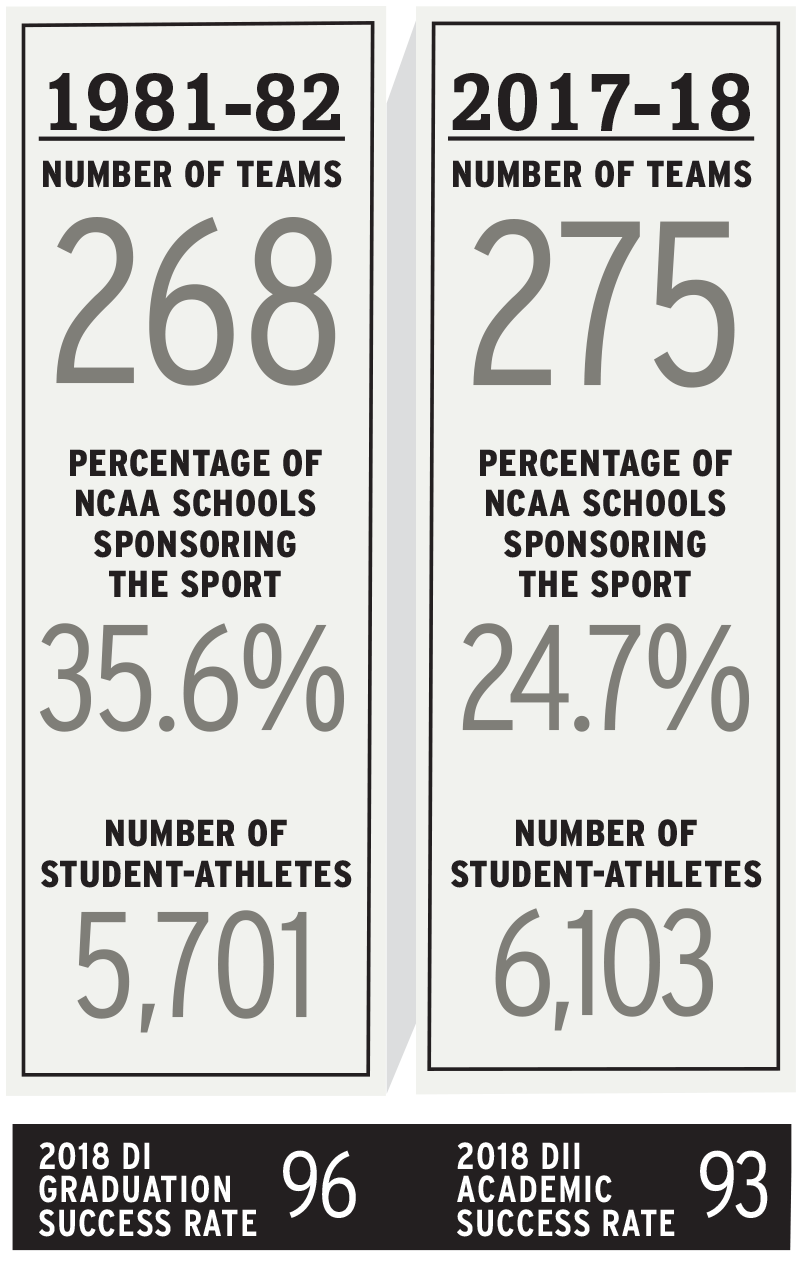
Over the past decade-plus, the sport has transitioned from a grass surface to artificial turf — an expensive change for NCAA schools, but one that saves money over time. Few field hockey teams play on grass today, and the NCAA prefers artificial turf for its national championships in all three divisions.
The number of NCAA women’s field hockey teams fell by 19 percent in the first 10 years of NCAA women’s championships as more opportunities in other sports became available to women for the first time. Field hockey has more than made up for that initial drop but has not kept pace with the rate of growth of NCAA schools overall. In 1981-82, more than 1 in 3 athletics departments sponsored field hockey; today, the number is 1 in 4.
Carli Figlio, field hockey coach at Monmouth and former chair of the Division I Field Hockey Committee, says the sport could grow by highlighting a strength field hockey brings to an athletics department: Among all NCAA student-athletes, field hockey players boast one of the highest Graduation Success Rates in Division I, at 96 percent, and are among the top Division II Academic Success Rates, at 93 percent.
“The growth is happening more west of the Mississippi and in the South because that’s where the growth can happen. We’re definitely keeping a bird’s-eye view on where teams are being added.”
Rebecca Begley | Hendrix field hockey coach and former Division III Field Hockey Committee chair
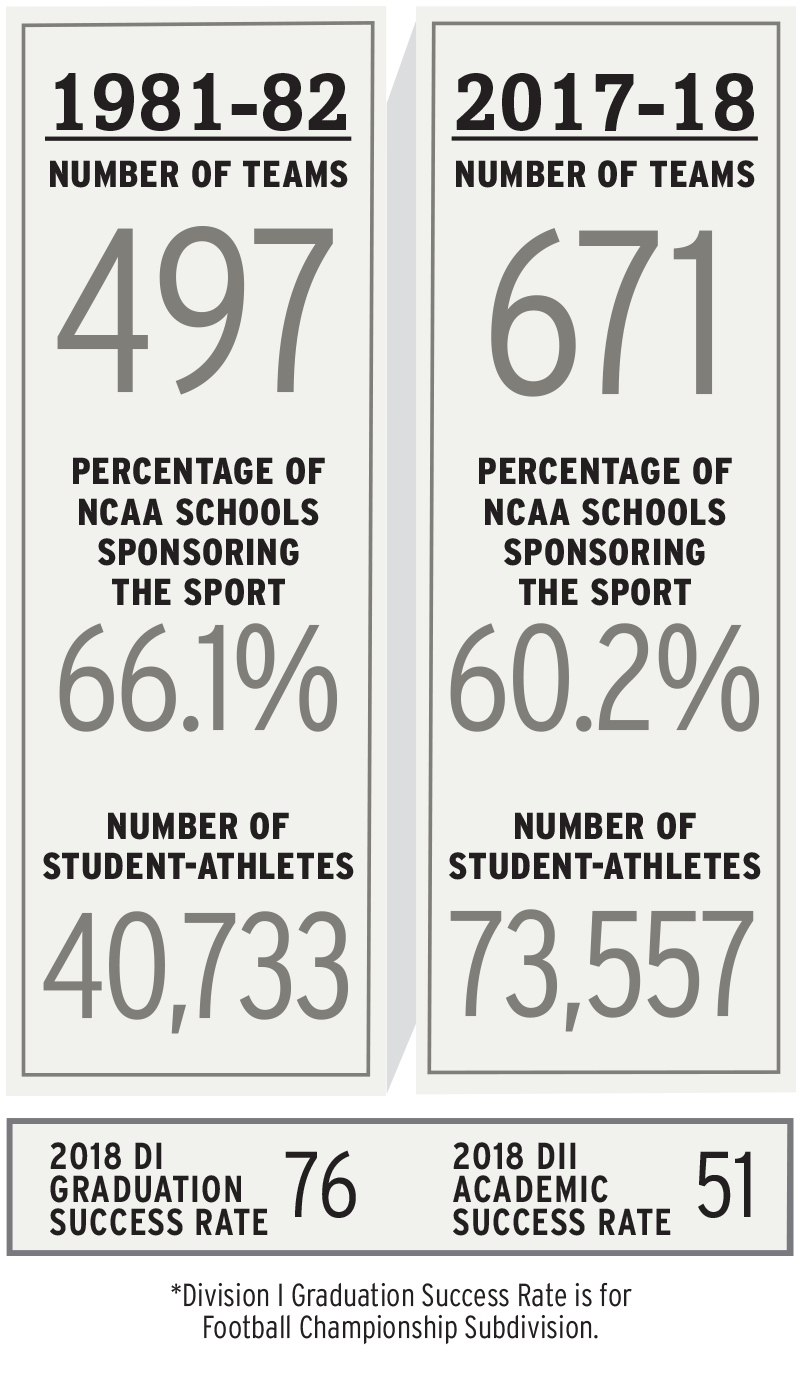
The desire to bolster player safety — namely reducing brain injuries and exposure to head impacts — has driven discussions and rule changes in recent years. Some decisions have garnered significant attention: Two-a-day practices, a long-standing preseason custom, were eliminated in 2017. In 2018, a rule that permits teams to fair catch kickoffs inside the 25-yard line and earn a touchback was put in place. Both changes were designed to curb injuries, particularly concussions.
High school participation rates in football dropped 6.4 percent from the 2008-09 academic year to the 2017-18 academic year, according to data from the National Federation of State High School Associations. While participation is falling at the youth level, the number of NCAA schools sponsoring football has increased 6.7 percent over the past decade.
New recruiting rules went into effect in 2017, including the addition of an early signing period in Division I. High school prospects now have a mid-December signing date that lasts 72 hours and coincides with the time junior college players can sign a National Letter of Intent. Prospective student-athletes also can wait until the traditional February signing period.
“The early signing has been positive so far. With this early date, it allows for the offers from the schools and the commitments from the players to be real. What everyone found out last December is that if a player decided not to sign early, he wasn’t really committed to making a decision. And if a school didn’t offer a scholarship (in December), then the offer isn’t real. What this has done is clarify the process for all involved. It will be interesting to see how everyone adjusts going forward.”
Todd Berry | American Football Coaches Association executive director

In college golf, champions are crowned via a variety of formats. After four days of stroke-play competition, the top eight teams advance to decide the Division I men’s and Division I women’s team champions through match play. The Division I men have determined a champion this way for 10 seasons, while the women are in the fifth year of match play. The Division II men’s and women’s national champions are decided by head-to-head medal play, and the Division III men and women crown their national champions through stroke play.
Currently, 61.5 percent of all NCAA athletics departments have a women’s golf team, and 75 percent of the Association’s schools have a men’s golf program. The women’s game is growing faster, though, with sponsorship levels jumping by 11 percent in the past five years. Meanwhile, the number of men’s programs crept up by 2 percent in the same time frame.
The Golf Channel holds the rights to men’s and women’s Division I national championship events until 2029 and televises both during back-to-back weeks, offering competitors a chance to shine in front of national audiences and eliciting more interest in the college game.
“In terms of the exposure for women’s collegiate golf, there is no doubt having the Division I championships televised is significant. The opportunity for young women to compete on a national stage with a national audience is something that hasn’t happened before in our sport.”
Roger Yaffe | Women’s Golf Coaches Association executive director

Changes are in store this year for both the men’s and women’s NCAA gymnastics championships. The women are moving to a format in which eight teams advance to the finals site instead of the current 12. The two-day competition will feature two semifinals the first day, with the top four teams advancing to the second day. For the men, a large number of ties in recent years — 26 at the 2017 championships and 28 in 2016 — have led the NCAA Men’s Gymnastics Committee to add one judge to each event at the qualifier and finals sessions.
Men’s gymnastics is sponsored by 80 percent fewer schools today than 36 years ago; sponsorship of women’s gymnastics has dropped by more than 50 percent over the same period. A steady increase in roster sizes, however, means the number of student-athletes competing in the sports has not declined as drastically. Between 1981-82 and 2017-18, the average number of men on gymnastics rosters has grown from 17.3 to 21.4; for women, the average roster size has jumped from 11.5 to 18.6.
Since shifting from a three-day to two-day championship format, men’s gymnastics has seen some attendance success. Last year’s event drew twice as many people as in 2017. Meanwhile, the women’s championships now air live on the ESPN family of networks, and the 2018 championships drew the highest number of spectators in four years.
“In our sport, other than five people every four years who make an Olympic team, college sports is the only place to go once you get out of a youth program. There’s no professional gymnastics, and it’s not a sport where you can play a pickup game on the weekend with your friends. College gymnastics is a home for all these gymnasts across the country to shoot for it and compete.”
Victoria May | Towson women’s gymnastics coach and NCAA Women’s Gymnastics Committee member

Debates about overtime format have been prevalent in recent years in men’s and women’s ice hockey. Conferences have experimented with a range of options, including five-on-five, four-on-four, three-on-three and shootouts. Which is the best for the sport? Disagreement prevails, though the committees that select, seed and bracket NCAA tournaments yearn for uniformity and consistency. Currently, all conference games must have a mandatory five-on-five, five-minute overtime. If the game remains tied, conferences may choose to play a five-minute, three-on-three overtime, followed by a sudden-death shootout or a shootout may be used immediately after the mandatory five-minute overtime.
The first National Collegiate Women’s Ice Hockey Championship was held in 2001. A year later, a separate Division III championship was added. Since the 2002-03 season, women’s hockey sponsorship has grown 45.7 percent, and 102 schools now sponsor the sport. On the men’s side, the sport has grown by 9.6 percent in the same time frame.
Determining an effective recruiting calendar has long driven conversation, particularly for the men’s game. Heavily recruited prospects have the option of playing high-level junior hockey. A legislative proposal that would provide NCAA coaches more flexibility, allowing them to begin recruiting prospects by Jan. 1 of their sophomore year of high school as opposed to Sept. 1 of the prospect’s junior year, is currently under consideration.
“When it comes to overtime, there are two schools of thought. One is we’re not the National Hockey League, and we only play 34 games. Making the NCAA tournament is the priority, and some people feel playing with less than five players on the ice is gimmicky. The other school of thought is more progressive, and we’re the only elite level of hockey that doesn’t play four-on-four or three-on-three overtime. Those groups of people wonder why we’re not changing with the times.”
Joe Bertagna | American Hockey Coaches Association executive director and Hockey East Association commissioner

What originated as a Native American game played mostly along the Eastern Seaboard and the Great Lakes has developed, particularly over the past two decades, into a fast-growing college sport. In one sign of its newfound popularity across the country, the San Francisco-based Pac-12 now offers a women’s lacrosse conference championship for its six schools that sponsor a team.
Over the past 15 years, the number of NCAA men’s lacrosse teams has increased by 77.6 percent, while the number of women’s teams has increased by 97.3 percent, making both sports the fastest growing for their genders over that time period.
The sport’s growth shows no sign of slowing. In the past two years alone, women’s lacrosse has added a net 22 teams, and the men’s game has added 18. Leaders in lacrosse credit that growth to a strong national organization that works to standardize the sport and grow interest in new regions.
“While lacrosse has been around for a long time, there haven’t been the infrastructure components for the game at a national level until really the last 15 years.”
Steve Stenersen | US Lacrosse president and CEO
Why is the popularity of lacrosse soaring at the college level? According to the nation’s lacrosse leaders, the surge has been no accident.
“We went through a process in the mid-’90s to ask, ‘How can we better position the sport for ongoing growth and development moving forward?’” says Steve Stenersen, president of US Lacrosse. “We concluded that we needed a consolidated entity that could aggregate resources to really fuel the sport and help generate interest. We also created more of a national strategy to execute over time.”
US Lacrosse began collecting national lacrosse participation data in 2001 and has watched nationwide participation swell from 250,000 that year to more than 800,000 today. “That’s overall participation — every youth level, high school, college, post-college,” Stenersen says.
The centralized effort has allowed lacrosse to work toward standardizing its rules from state to state and how it trains and develops coaches and officials. Last year, the sport experienced a breakthrough: The Pac-12 added a women’s lacrosse championship, making it the fifth lacrosse championship among the five NCAA autonomy conferences. In addition to the Pac-12 event, the Big Ten and Atlantic Coast Conference offer men’s and women’s conference championships; the Southeastern and Big 12 conferences, though, do not sponsor men’s or women’s conference championships.
Stenersen offers some perspective for sports communities that are trying to grow their numbers: Thirty-six years ago, when the NCAA began collecting participation data, only 14 percent of schools offered women’s lacrosse, and 18 percent offered men’s.
Today 45 percent sponsor women’s lacrosse and 34 percent sponsor men’s.

Thanks to recent technological enhancements — including those that bolster safety — the National Collegiate Men’s and Women’s Rifle Championships can now be held in basketball arenas. This development makes it possible for schools with long rifle traditions and loyal fan bases to welcome spectators and improve the competitors’ experience.
Rifle is a rare NCAA sport in which men and women compete together, and just 350 student-athletes participated in rifle nationwide last year, according to 2017-18 NCAA participation data. (Fifty-six percent of those competitors were women.) While the number of teams sponsoring rifle for women has remained mostly constant in recent years, the number of teams that include men dropped in 2017-18 to a record-low 22.
The rifle community is optimistic about spurring interest in the sport now that new safety features introduced at the national championships allow arena seating for spectators. But coaches also are aware that part of their job is educating those who aren’t familiar with the sport.
“We don’t want our sport to be about gun control because that’s not what we do. A lot of times that kind of gets tacked onto our world very easily. So we talk about how to promote and grow the sport and keep it safe.”
Ashley Rose-MacAllister | Nebraska rifle coach and NCAA Men’s and Women’s Rifle Committee member
Student-athletes competing in NCAA men’s and women’s rifle remain some of the rarest within the NCAA: Nationwide, they number just 350 students. But recent enhancements at the national championships have made the sport more accessible to fans.
The rifle community hopes that move will translate into more interest and excitement — and, perhaps, more schools interested in sponsoring the sport.
A new portable firing range, built from sheet metal-enforced plywood, has become a game changer for the sport’s championships. Developed at Akron as the school was planning to host the 2016 National Collegiate Men’s and Women’s Rifle Championships, it moved the championship competition from a firing range — or even a hotel ballroom — to an indoor facility designed for spectators.
Melissa Mulloy-Mecozzi, rifle coach at MIT and a recent chair of the NCAA Men’s and Women’s Rifle Committee, calls the development a “championship in a box” and says it has opened the door for schools with strong fan support for their rifle teams to host the championships for the first time.
The 2018 NCAA finals took place at The Citadel’s McAlister Field House in Charleston, South Carolina. This year’s championship will be hosted by West Virginia, which has won the national rifle team title 19 times but never on its home turf.
“We’ve got bleachers, concessions, video boards,” Mulloy-Mecozzi says. “Spectators know who’s in the lead, who’s in contention. It’s a lot more memorable for our student-athletes.”
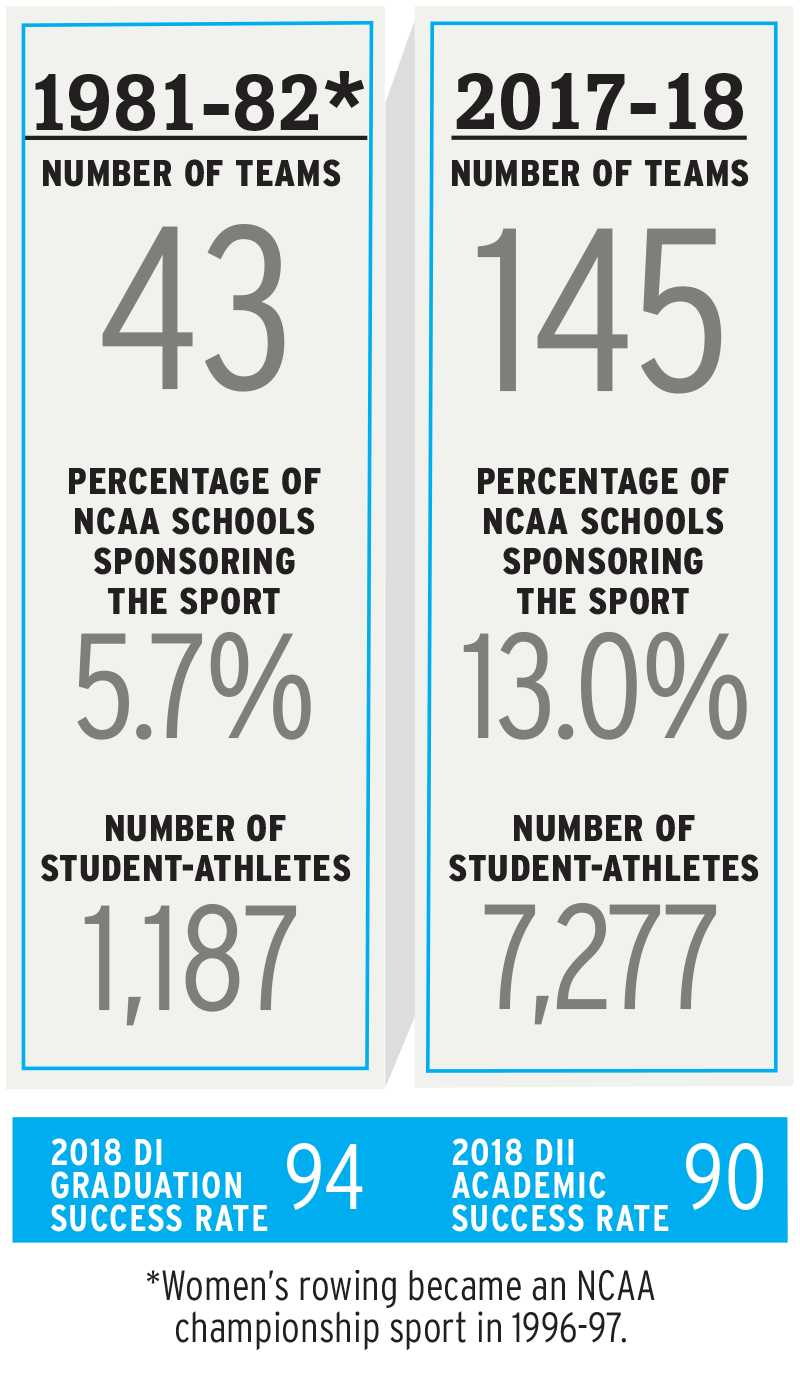
Women’s rowing has a lot to celebrate: The number of teams has more than tripled since the 1981-82 academic year, and interest at the youth level is flourishing. And the rowing championships themselves? They’re downright fun, bringing together Divisions I, II and III for high-stakes racing at a single site. “It makes the championship feel like a big, grand experience, which is pretty awesome,” says Wendy Bordeau, rowing coach at Dartmouth and a member of the Division I Rowing Committee. “It’s such a huge endeavor.”
The quality of competition has increased along with the sport’s popularity. Andy Derrick, rowing coach at Seattle Pacific and chair of the Division II Rowing Committee, points to the early years of the Division II championship, when Western Washington won seven consecutive titles. Over the past seven years, by comparison, five different teams have taken the trophy home.
Leaders in rowing continue to see growth potential for the sport, partly because it is a women’s sport with a high number of roster spots. The average NCAA women’s rowing squad has 50 student-athletes, but it’s not unusual for teams to boast 80 — or even 100 — women on a roster.
“You can have an all-star on the boat, but you’re in that boat together, and every single person needs to perform. That’s something that’s really special about our sport.”
Kendall Mulligan | Georgetown rowing coach and former Division III Rowing Committee member

The NCAA Men’s and Women’s Skiing Committee has worked to make its championships more spectator-friendly, both for those on-site and for those at home. Competitors now race in smaller loops in some events, allowing fans to see them multiple times. Plus, an impressive scoreboard allows onlookers to follow the action. Sten Fjeldheim, the Nordic skiing coach at Northern Michigan since 1986 and a member of the skiing committee, says the impact of the enhancements became clear to him last year when he returned to campus with junior Ian Torchia, who had just won the individual men’s title in Nordic skiing and was greeted by an athletics department that had watched him win via livestream. “Before, I’d have to explain the details to people when I got back,” Fjeldheim says. “But this time, everybody was really excited about it and was talking about the moves Ian made. The livestream brought the race to the spectators.”
The number of skiing teams has held relatively constant for years now, though that number is low. Only 3 percent of NCAA schools offer men’s or women’s skiing, a proportion that has remained steady for nine years for men and eight years for women.
Ten of the past 11 national champions have come from the states of Colorado or Utah, but the coaching community still sees growth potential in the western U.S. and Minnesota, where skiing is a popular high school sport.
“Not every school can have a ski team. We’re limited by geography. But there are plenty more schools out there that could.”
Brian Blank | New Hampshire skiing coach and NCAA Men’s and Women’s Skiing Committee member

Many Olympic swimming standouts have NCAA roots. In 2016 in Rio de Janeiro, luminaries like Simone Manuel, Lilly King and Missy Franklin had recently competed on the NCAA level. On the men’s side, the same held true for Ryan Murphy, Cody Miller and divers Steele Johnson and David Boudia.
In the 1981-82 season — the first year the NCAA sponsored women’s championships — 46.3 percent of schools had varsity women’s swimming and diving teams. That figure has grown only slightly in the decades since; in 2017-18, 49.8 percent of all NCAA schools sponsored a team. Men’s swimming and diving, though, has experienced the inverse. In 1981-82, 50.1 percent of NCAA schools had men’s swimming and diving. In 2017-18, that figure stood at 39.4 percent.
Like many of the Association’s sports, technology is driving innovations and conversations in swimming. Video review is available for false starts, relay takeoffs and timing system malfunctions. Up next? The NCAA Men’s and Women’s Swimming and Diving Rules Committee has begun discussing the viability of wearable tracking technology.
“Video is a tremendous way to make sure we aren’t harming the student-athlete. We’d hate to see someone not given credit because of a technical malfunction. It protects the integrity of the competition.”
Greg Earhart | College Swimming and Diving Coaches Association of America executive director

For the 2019 season, bats must bear either the permanent Amateur Softball Association 2004 sticker or the new fastpitch USA Softball certification mark to be used in competition. The current NCAA-approved softball bat list is maintained on the NCAA and the Softball Umpire Program websites.
When the NCAA began sponsoring women’s championships in the 1981-82 academic year, 55 percent of Association schools fielded varsity teams. Today, almost 90 percent of the schools across all three divisions sponsor the sport.
When Michigan won the Division I softball title in 2005, it marked the first time a team from east of the Mississippi River took home the trophy. The Wolverines’ championship wasn’t an aberration — four of the past seven national champions reside east of the river. Nowhere is the eastward expansion of power more apparent than in the Southeastern Conference, where all 13 programs that sponsor the sport sent teams to the 2017 and 2018 NCAA tournaments. Schools across the country are devoting more resources to softball, including new venues and enhanced facilities, ensuring the sport will have a national footprint for years to come.
“(In the SEC), you are playing in front of a postseason crowd every game, and most importantly, you have to manage your pitching staff through a grinding three-game series. You make the type of decisions that have to be made in the postseason.”
Rachel Lawson | Kentucky softball coach

In recent years, the NCAA Men’s and Women’s Soccer Rules Committee has made a number of changes to enhance the sport and in-venue fan experience. Video review can be used to determine if a goal has been scored, to identify players for disciplinary matters, and to determine if a fight occurred and who participated. To ensure a lively environment, school bands can now perform throughout the game and fans can use artificial noisemakers.
More than 93 percent of the Association’s athletics departments have varsity women’s soccer teams, and almost 28,000 women competed in the sport during the 2017-18 academic year. On the men’s side, nearly 75 percent of NCAA schools have men’s soccer teams, which boast more than 25,000 participants.
At the Division I men’s level, the notion of moving to a two-semester model — possibly starting in September and ending in May — has been discussed. While it hasn’t gained traction in the governance process, some in the soccer community believe the schedule shift could enhance the sport. For example, more matches could be scheduled on weekends, which would equate to less missed class time and more recovery time between matches for student-athletes.
“Many conversations pertaining to soccer focus on two areas: the proper amount of preseason training as well as sufficient rest and recovery between games. These areas address injury prevention and energy generation and are essential for producing healthy personal, academic and soccer balance.”
Rob Kehoe | United Soccer Coaches director of college programs

Improving the pace of play in the men’s and women’s game has been a priority in recent years. In the past, a dual match at the championship could take up to five hours to complete. After a series of scoring format changes, though, matches are now typically completed in a two- to three-hour window in Division I. The move to no-ad scoring in all matches at the NCAA championships starting in 2016 (Division II is making the change in 2019) has helped shorten the time it takes to play matches, and doubles contests have been reduced to one set with a tiebreaker if the score reaches 6-6.
More than 20,000 international student-athletes study and compete in NCAA sports, and tennis has contributed the largest contingent. During the 2016-17 academic year, 58 percent of the competitors in Division I men’s tennis came from outside the U.S. In Division I women’s tennis, 55 percent of the players were international student-athletes. Most hail from Spain, the United Kingdom, Germany and Australia.
Recruiting across the globe may seem daunting, but college programs can rely on a tool called Universal Tennis Rating, an online service that uses match results to rate tennis players from more than 200 countries.
“Tennis is a global sport, and higher education is also global. We feel this is a strength to our sport. Once we get everyone on a team, the presence of international students makes our game richer.”
Tim Russell | Intercollegiate Tennis Association chief executive officer
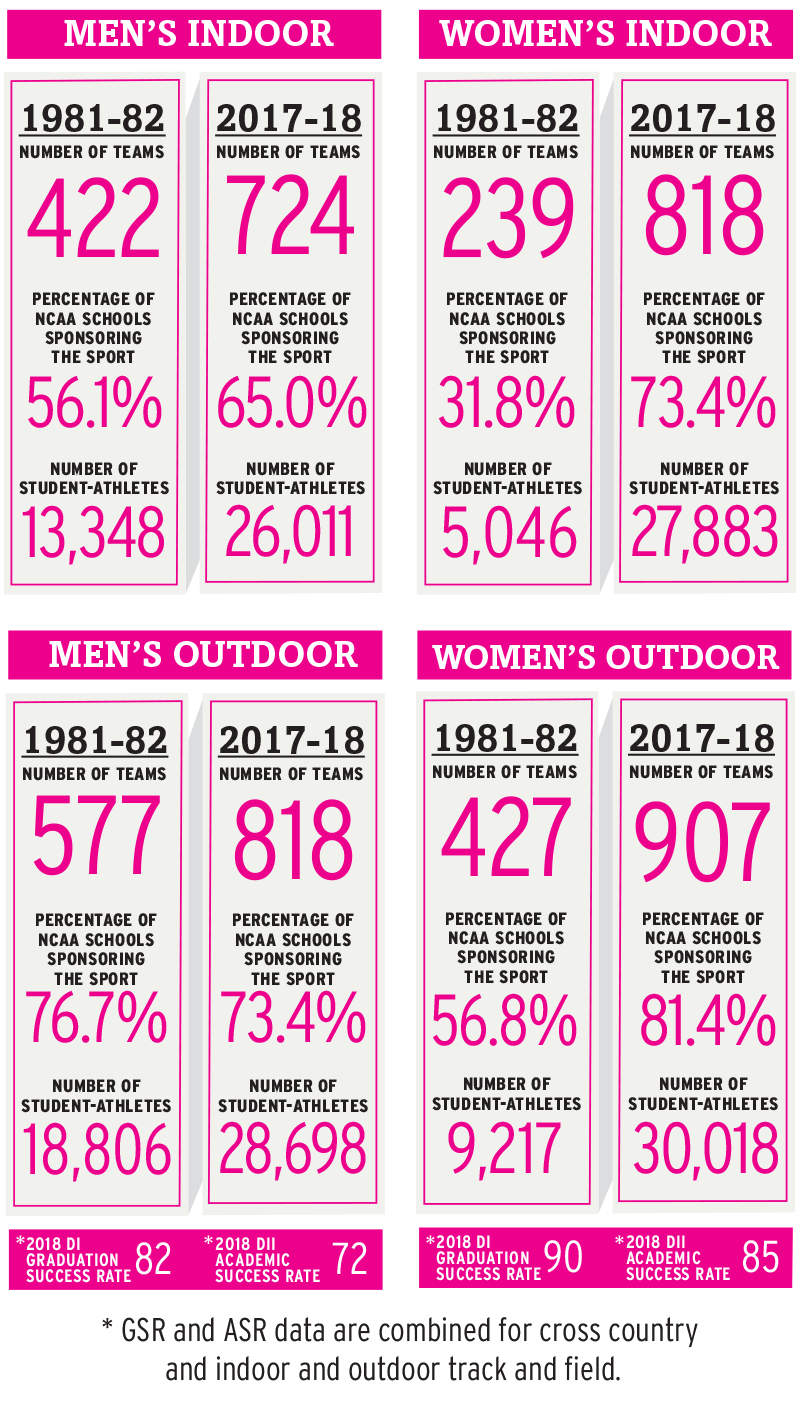
Outdoor track and field is the NCAA’s oldest championship sport, with the first title awarded in 1921. But the increasing popularity of indoor track and field is leaving coaches responsible for preparing college athletes to compete throughout the year. “We want what’s best for our student-athletes,” says Wendy McFarlane-Smith, track and field and cross country coach at Delaware and a member of the Division I Men’s and Women’s Track and Field and Cross Country Committee. “Now, what is that? That’s what we try to decide.”
Today, 30,018 women compete in NCAA outdoor track and field — more than in any other sport. Over the past 35 years, growth in men’s outdoor track and field has kept pace with that of the NCAA overall. The popularity of the indoor sport is also injecting new excitement: The number of women’s indoor teams has increased 11.6 percent in five years; for men, the number of teams has jumped 11.2 percent.
For college track and field, the future is here. Up-to-the-minute results and split times for every competitor in every event mark major advancements in the sport. Coaches and staff have adjusted accordingly — no more faxing results and collecting pages of paperwork. “Now you just hit the ‘submit’ button,” says Don Nichter, cross country and track and field coach at Dickinson.
“At its base, track and field is athletics. That’s the beauty of the sport. It still always allows athletes of all different backgrounds, all different sizes and shapes, to have a place on the track and field team.”
Don Nichter | Dickinson cross country and track and field coach and a member of the Division III Men’s and Women’s Track and Field and Cross Country Committee

It seems this sport’s national championship should be called the National California Water Polo Championships. In the men’s 50-year history, only seven different schools have claimed the championship — all of them are located in the Golden State. For women, three California schools have won all 18 championships.
For both men and women, water polo’s numbers have remained stable for more than a decade. The water polo community is trying to demonstrate its value to schools that have underused facilities. “Some of the schools that are big in swimming and diving already have facilities established,” says Natalie Benson, women’s water polo coach at Fresno State and the chair of the NCAA Women’s Water Polo Committee. “That’s where our sport can really start to make a big jump if it’s added at some schools outside California.”
A lot of sports are eyeing growth, but men’s and women’s water polo has its focus on one state in particular: Texas, where water polo was recently added as an official high school sport. Division III Austin College added men’s and women’s teams this year, becoming the first school in the state with collegiate water polo.
“What ADs miss at times is the immense cost it takes to run an actual pool. The cost of running an aquatic facility is quite high, so having programming in that pool to offset those costs is very valuable. Either we have this pool collecting dust while we pay $150,000 or $200,000 a year, or we have students use this thing.”
John Abdou | USA Water Polo chief high performance officer

The inaugural Division III Men’s Volleyball Championship was added in the spring of 2012. By the 2017-18 season, 91 Division III schools had varsity men’s volleyball teams. At the National Collegiate level, 44 teams competed during the 2017-18 academic year (22 each in Division I and Division II).
Spurring growth has been top of mind for those involved in the sport. Since 2012-13, the number of NCAA men’s volleyball teams has grown nearly 29 percent. Much of that can be credited to Division III, where the number of teams grew 44 percent during that time frame.
According to the National Federation of State High School Associations participation rates survey, more than 2,400 schools in 24 states had boys volleyball teams as of 2017-18, which equated to 60,976 participants nationwide.
“One of the things we are excited about is that opportunities for men are starting to increase in the sport. It has not been a bonanza at Division I. We’re hoping Division II could grow robustly in the next 10 years. It is an attractive demographic for colleges. Many of the players are coming from homes where there is a lot of academic support and an expectation of going to college. If you already have a women’s team, the men could utilize the same equipment, and you’re not doubling up on gym time because the women play in the fall and the men would play in the spring.”
Kathy DeBoer | American Volleyball Coaches Association executive director
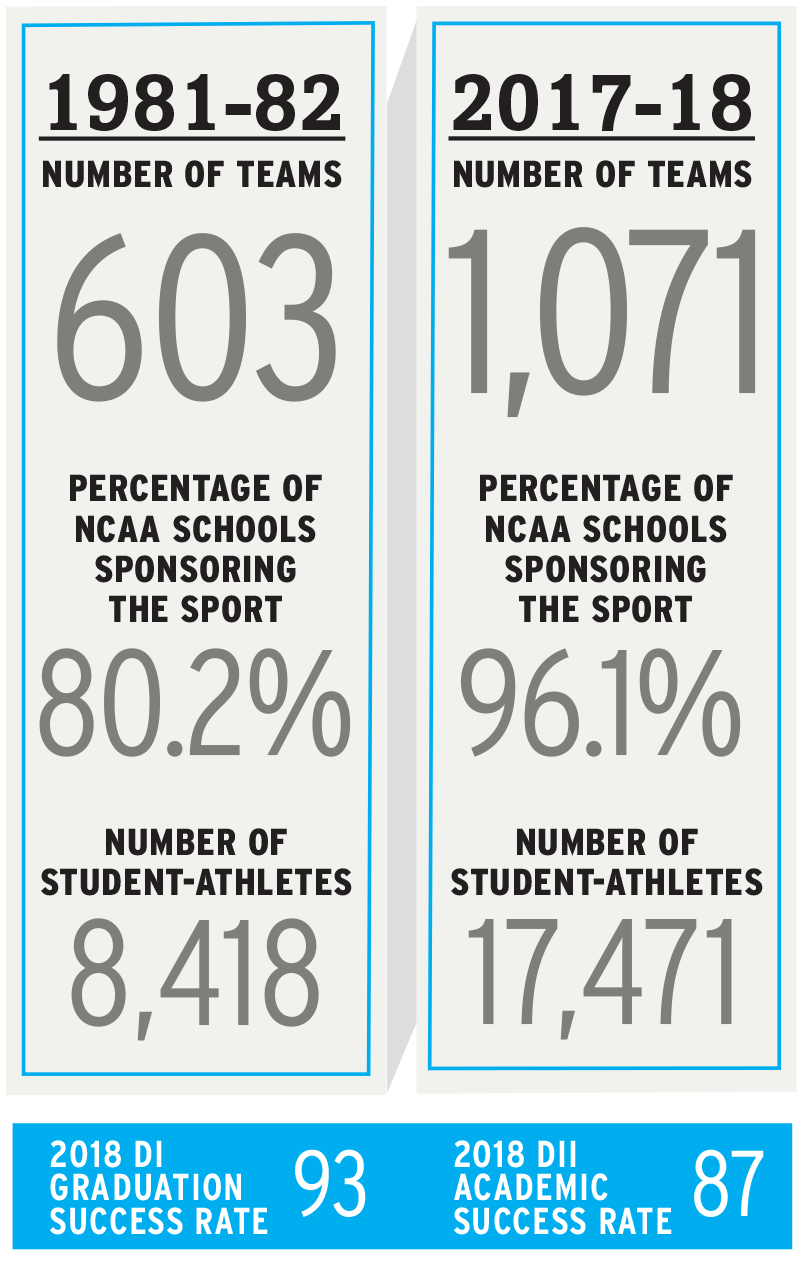
In a fast-paced sport where inches matter, video review challenges have been allowed for the past three seasons in any venue that can accommodate them. As of 2018, coaches are permitted to challenge in-out calls and touch calls without specifying which aspect of the play they want to be reviewed.
When the NCAA began conducting women’s championships in the 1981-82 academic year, 80.2 percent of all schools in the Association had varsity women’s volleyball teams. By 2017-18, that number had jumped to 96.1 percent.
The sport’s pipeline is flowing steadily. The best evidence? According to the National Federation of State High School Associations, the 2014-15 academic year marked the first year that more girls played high school volleyball (432,176) than basketball (429,504). The trend continued during the ensuing three years and, as of 2017-18, volleyball claimed 34,176 more high school athletes than women’s basketball.
“It is an exciting trend for us and is indicative of women’s volleyball being healthy. The growth is organic. Volleyball is a sport that girls have built. Girls invited other girls to play the sport, and once they started playing the sport, they decided to keep playing.”
Kathy DeBoer | American Volleyball Coaches Association executive director
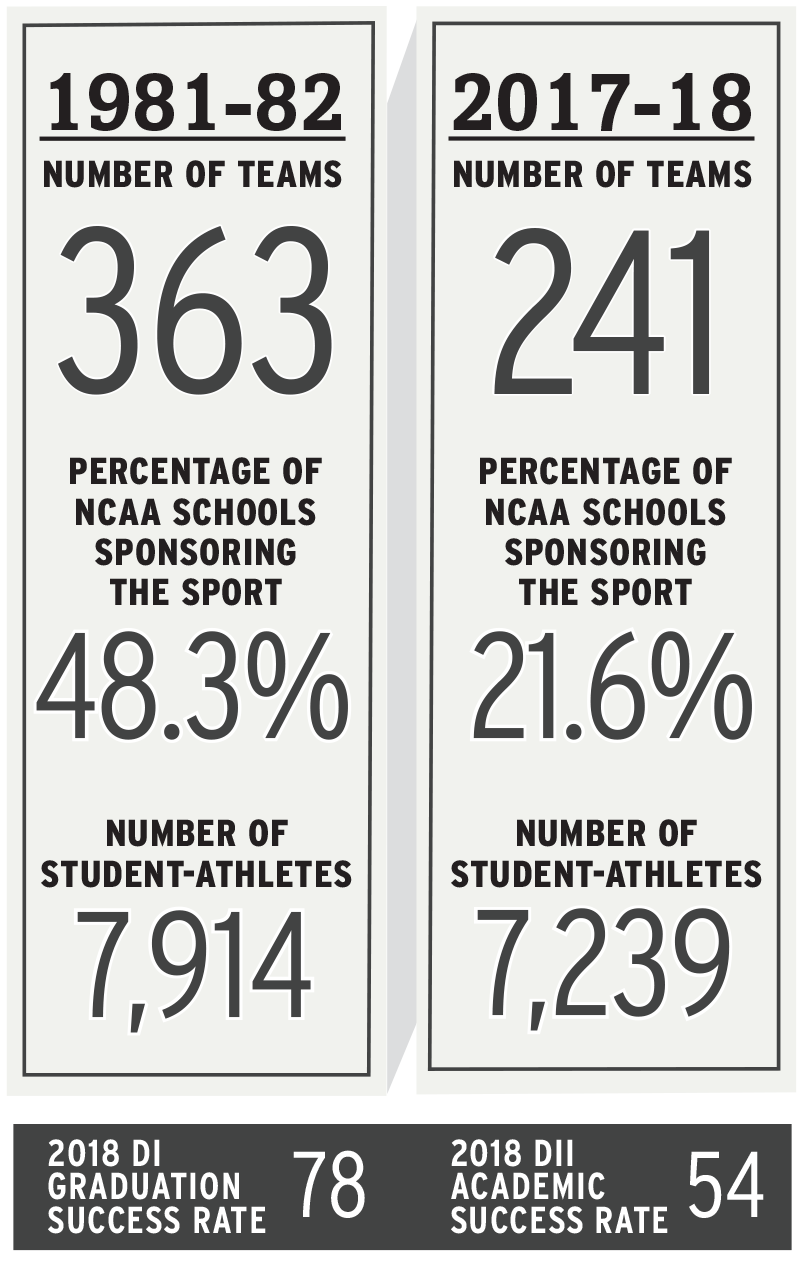
Stiffer penalties were recently introduced for competitors who violate weight certification protocols. The consequences for cutting corners are severe: Wrestlers now are required to miss eight consecutive competitions for a first offense and must sit out a year if they commit a second. What constitutes a violation of the new rules? Urine manipulation during weight assessments; use of rubber suits, saunas, diuretics or intravenous rehydration; and skin check forgery or deception. They’re all methods for either dropping weight quickly before a match or covering up efforts to do so. Wrestlers found to be in violation also are required to recertify their weight at some point during the suspension period.
The last time more than 100 schools fielded varsity wrestling teams at the Division I level was 1995-96, when 106 teams took to the mat. In Division II, the sport had an all-time low 38 schools sponsoring the sport in 2002-03 but rebounded to 60 programs by 2017-18. In Division III, 17 varsity teams have been added since the 2012-13 season, pulling the total up to 105 squads last season.
Growing the sport is always top of mind in the college wrestling community. In recent months, that constituency received good news when the University of Arkansas at Little Rock and Presbyterian announced plans to start Division I programs by the 2019-20 academic year.
“It’s exciting knowing that we will soon have our first-ever Division I men’s wrestling program in the state of Arkansas. Besides the men’s program at Presbyterian, they will also add a women’s wrestling program.”
Mike Moyer | National Wrestling Coaches Association executive director

This story originally appeared in the Winter 2019 issue of Champion magazine.